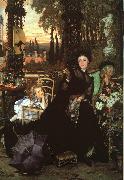Wholesale Oil Painting No Minimum |
|||||||||||
|
|
|||||||||||

|
|||||||||||
|
|
|
||||||||
James TissotFrench Painter, 1836-1902 French painter, printmaker and enamellist. He grew up in a port, an experience reflected in his later paintings set on board ship. He moved to Paris c. 1856 and became a pupil of Louis Lamothe and Hippolyte Flandrin. He made his Salon d?but in 1859 and continued to exhibit there successfully until he went to London in 1871. His early paintings exemplify Romantic obsessions with the Middle Ages, while works such as the Meeting of Faust and Marguerite (exh. Salon 1861; Paris. Mus. d'Orsay) and Marguerite at the Ramparts (1861; untraced, see Wentworth, 1984, pl. 8) show the influence of the Belgian painter Baron Henri Leys. In the mid-1860s Tissot abandoned these tendencies in favour of contemporary subjects, sometimes with a humorous intent, as in Two Sisters (exh. Salon 1864; Paris, Louvre) and Beating the Retreat in the Tuileries Gardens (exh. Salon 1868; priv. col., see Wentworth, 1984, pl. 45). The painting Young Ladies Looking at Japanese Objects (exh. Salon 1869; priv. col., see Wentworth, 1984, pl. 59) testifies to his interest in things Oriental, and Picnic (exh. Salon 1869; priv. col., see 1984 exh. cat., fig. 27), in which he delved into the period of the Directoire, is perhaps influenced by the Goncourt brothers. Tissot re-created the atmosphere of the 1790s by dressing his characters in historical costume. |
||||||||
|
|
||||||||
Une Veuve (A Widow)
Une Veuve (A Widow) Painting ID:: 1652 |
1868 1868 |
|||||||
|
|
||||||||
|
James Tissot French Painter, 1836-1902 French painter, printmaker and enamellist. He grew up in a port, an experience reflected in his later paintings set on board ship. He moved to Paris c. 1856 and became a pupil of Louis Lamothe and Hippolyte Flandrin. He made his Salon d?but in 1859 and continued to exhibit there successfully until he went to London in 1871. His early paintings exemplify Romantic obsessions with the Middle Ages, while works such as the Meeting of Faust and Marguerite (exh. Salon 1861; Paris. Mus. d'Orsay) and Marguerite at the Ramparts (1861; untraced, see Wentworth, 1984, pl. 8) show the influence of the Belgian painter Baron Henri Leys. In the mid-1860s Tissot abandoned these tendencies in favour of contemporary subjects, sometimes with a humorous intent, as in Two Sisters (exh. Salon 1864; Paris, Louvre) and Beating the Retreat in the Tuileries Gardens (exh. Salon 1868; priv. col., see Wentworth, 1984, pl. 45). The painting Young Ladies Looking at Japanese Objects (exh. Salon 1869; priv. col., see Wentworth, 1984, pl. 59) testifies to his interest in things Oriental, and Picnic (exh. Salon 1869; priv. col., see 1984 exh. cat., fig. 27), in which he delved into the period of the Directoire, is perhaps influenced by the Goncourt brothers. Tissot re-created the atmosphere of the 1790s by dressing his characters in historical costume. Une Veuve (A Widow) 1868 |
||||||||
|
|
||||||||
|
Prev Next
|
||||||||
|
|
||||||||
|
Related Paintings to James Tissot :. |
||||||||
|
|
||||||||
|
CONTACT US |

